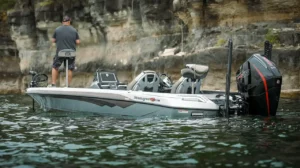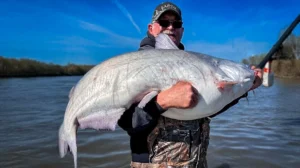Scouting water from a boat in the fall is a good way to learn the best places to catch crappie and walleye at the start of the ice fishing season. Late fall locations for these species are often the same as, or near, where fish will be at first ice. Saving GPS waypoints marking healthy vegetation or fish in the fall eliminates a lot of guesswork of where to go when ice arrives. Fall scouting works for a range of sport fish, but in this story our focus is walleye and crappie tactics.
Here’s a 4-part breakdown giving tips on where to look and how to scout first ice spots for walleye and crappie in the fall.
- Boat scouting efficiencies
- Where to start
- Fish spots to confirm
- Scout access spots
Boat scouting efficiencies
Scouting water in the fall from a boat to prepare for ice fishing makes a lot of sense. Mobility’s better in a boat. It’s certainly a faster and easier way to cover water than searching for fish on ice.
The basic recipe involves using sonar to find spots and fishing them to confirm the presence of fish. Productive spots and structures are saved as GPS waypoints. Anglers take notes on a lake map as an alternative to GPS.
Waypoints are then transferred to a portable ice sonar/GPS combo or a handheld GPS unit for winter. At first ice, getting on biting fish then only requires a short walk to marked locations with waiting fish.
Fall scouting’s good to do for any system, but the rewards are high when done on remote lakes, small ponds and other waterbodies without electronic depth charts.
A boat outfitted with side-imaging or 360 technology makes scouting more efficient compared to traditional 2D fish finders, which dominates ice sonars. While I know some ice anglers experiment with advanced sonar technologies, their use on ice isn’t as trouble free as in a boat.
Boat sonar provides a continuous display while moving through an area. On ice, anglers only get a picture of the patch of water within the sonar cone below an ice hole. Imagine exploring a new area with your boat, but the sonar only displayed data at 10-yard intervals. This is an illustration of how piecemeal things can be on ice compared to open water scouting, where data streams without interruption.
Although chilly, temperatures and conditions are typically better in fall. Tasks are easier, too. For one, using an underwater camera and managing its cord is trouble free from a carpeted boat deck compared to standing over a 6- to 8-inch hole surrounded by snow and ice.
Where to look
There are never any guarantees, but by late fall crappie and walleye are often in or near the areas where they’ll be at first ice. Here are 4 tips on where to look when scouting for ice hotspots.
Healthy weeds
Deep, lush vegetation appeals to crappie and walleye in fall and winter. As shallow plants die-back much of the food chain slides away from shore. They often relate to to remaining healthy weeds. The concentration of baitfish and other food attract crappie and walleye to the greenery.
Healthy weeds near other structures are especially good. Common examples include rocky points and reefs, sand bars and deep, soft-bottom flats.
In rivers, be sure to explore backwater areas for healthy weeds. Crappie often overwinter in these back bays to get away from the main channel’s current. Walleye, too, in certain instances.
Deep basins
If you’re a fan of catching big crappie and other panfish be sure to explore 20 to 35 foot lake basins with soft-bottoms. Crappie spend much of the winter in these bowls, and are in these spots by late fall in many lakes.
The basin’s muddy bottom contains a buffet of invertebrates panfish eat. Expect crappie to hang out around steep basin edges, bars and bends.
Learn more about this winter pattern by reading this story on Filter Feeding Crappie with Scott Glorvigen.
Classic structure
Rocky points, sand bars, mid-lake humps and reefs are common winter hangouts for walleye. I like structures topping out somewhere between 18 to 30 feet, near basins and deep flats between 40 to 60 feet.
Marking baitfish is important when scouting structure. If there isn’t food around, the area’s unlikely to hold walleye in winter.
Structure’s important for crappie, too. They’ll often use points, bars and ridges on flats as migration routes from deep water to shallow food shelves at dusk. Having waypoints of these structures lets an angler precisely drill holes over these pathways and catch a bunch of fish.
Look for mid-winter spots
Scouting in the fall rewards anglers at first ice, but be sure to think of mid-winter, too. Generally speaking, walleye and crappie slide to deeper areas – if they weren’t already deep – after the first few weeks of the ice season.
Look for deep flats near late fall/early ice hangouts. Scan flats for bottom transitions, rock piles, sand deposits and depressions. These variations concentrate walleye and crappie and funnel their movements on flats.
Fish spots to confirm
Fall scouting isn’t only about studying the sonar and entering GPS waypoints. You need to fish, too. For one, catching fish confirms you’ve located your target species. It also gives clues on tactics to try when ice arrives. Here are some examples.
Test assumptions
Walleyes and crappie are known to feed at dawn and dusk in winter. This is most pronounced in clear water lakes. Yet, I’ve patterned “day bites” for both species on many different types of water bodies in fall.
Learning how a lake fishes helps plan trips on the ice. A day bite gives lots of fishing time between sunrise and sundown. On the flip side, where a lake only has a dusk bite, there’s little point drilling holes until late afternoon for crappie or walleye. Chasing yellow perch in the day likely a better use of your fishing time.
Food clues
Knowing the forage walleye and crappie are eating helps pick the best tactics to catch them. Keeping a few fish caught in the fall for the table and examining their stomach contents is one option.
Harvesting fish isn’t always needed though. I’ve seen juvenile perch on sandy areas when fishing walleye in the fall, which was a hint to use perch colored jigging minnows and spoons on ice. On another trip fall scouting crappie, I snagged weeds covered in freshwater shrimp, a panfish delicacy easily matched with a white or smoke tube jig or finesse plastic.
Experiment with baits and colors
Fall outings are also good opportunities to experiment with different lures and colors to see if fish have certain preferences. While a lot can change between the fall and first ice, it’s at least a starting point.
Confirm winter access
A public boat launch makes it easy to access a lake from spring to fall. Don’t assume getting on the ice will be as straightforward.
A launch can still offer access. But, finding where to safely park your vehicle can be a common glitch as a result of snowfall accumulation or winter parking restrictions. Internet research and a call to a local tackle shop are ways to determine if parking’s available.
I’m lucky and have winter access to many lakes through friends’ cottage properties. Keeping in touch, helping out with chores and delivering thank-you presents of fresh fillets goes a long way to ensuring these kind folks don’t mind me tramping on their property in the winter to go ice fishing.
Scouting ice fishing lakes in the fall helps locate deep, healthy vegetation and structures where crappie and walleye will be in the winter. This short amount of on-the-water homework will ensure you have some great fishing action when the hard-water season starts. Do it right, and you’ll drill a lot less holes and catch a lot more fish at first ice.












